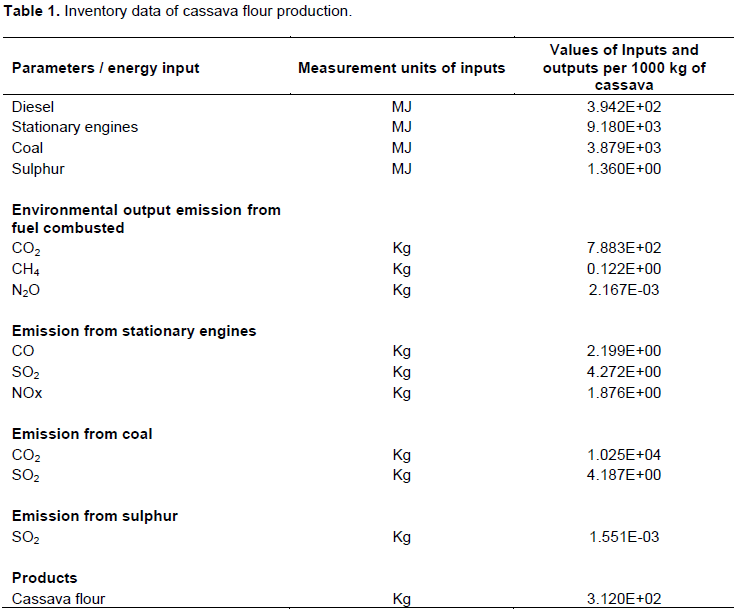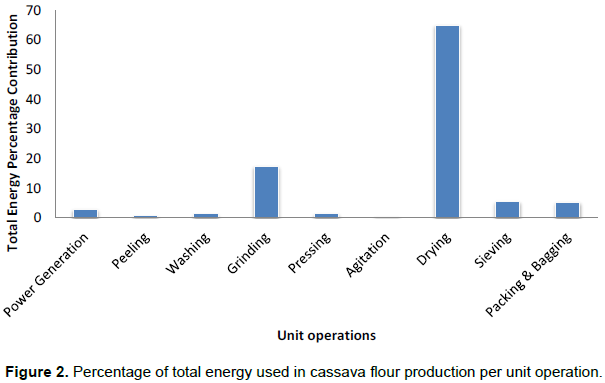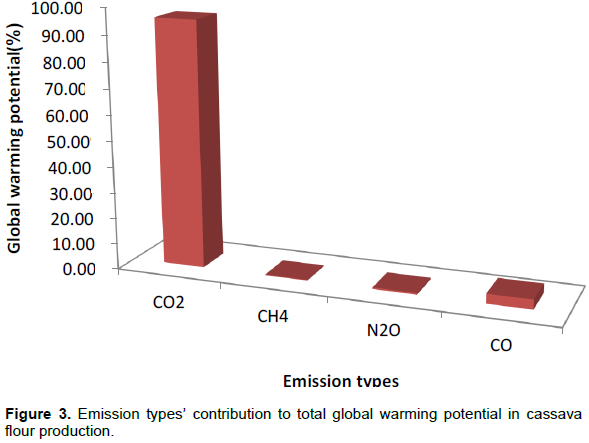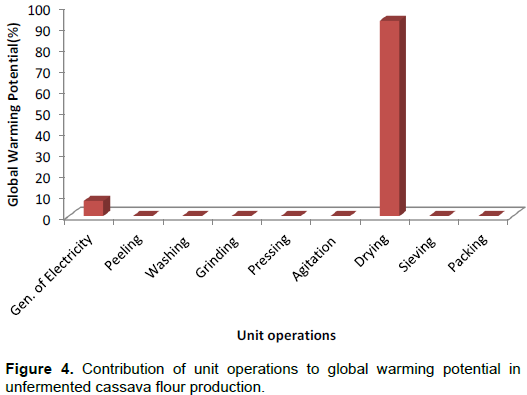ABSTRACT
Global climate change resulting from increased greenhouse gas emission and environmental pollution remain a serious threat to the world. Food processing industries is one of the major contributors to global greenhouse gas emissions. Intergovernmental Panel on climate change (IPCC) reported that greenhouse gas emission should be reduced to avert the worst effects of climate change. One of the ways to reducing greenhouse gas emission is by assessing the environmental impact associated with food production, and one of the well-known methodologies used for environmental impact evaluation is life cycle assessment model (LCA). This paper presents the results of LCA analysis of cassava flour production in Southwestern Nigeria. The result shows that global warming potential of cassava flour production was 1.105E+01 kg CO2 equivalent, eutrophication 2.632E-03 kg NO3 equivalent and acidification 5.583E-03 kg SO2 equivalent. In this study, the major contributor to global warming is the carbon dioxide (CO2) emission from burning of fossil fuel (Coal) used for drying operation which emits 93% of the CO2, while 7% of the total CO2 emission is from the diesel generator. This study has shown that cassava flour production is contributing greatly to environmental global warming potential in Southwest Nigeria.
Key words: Greenhouse gas, life cycle assessment, global warming, eutrophication, acidification.
Cassava (Manihot esculanta crantz), is extensively cultivated as annual crop in the tropical and subtropical regions of the world for its edible, starchy, tuberous root which serve as a major source of carbohydrates. Cassava, under adverse growth conditions may take about 18 months to produce crop, and 8 months under favourable conditions. Cassava tolerates a wide range of soil pH (4.0 to 8.0). It grows best in the full sun. Traditionally, it is grown in a Savannah climate, but it can grow in a wide range of rainfall conditions such as 1000 to 2000 mm/a (Kuiper et al., 2007).
Cassava ranks third on the list of major food crops in developing countries after rice and maize with production in 2010 estimated at 249 million tonnes (UNCTAD, 2012). During the last decade, the output of cassava has grown much faster in Africa than in the other major producing regions due to increasing cultivation. Thus, cassava is critical to the food security strategy in the world particularly the third world nations. According to FAO statistics in Worldlistmania (2016), Nigeria is the largest producer of cassava in the world, with a production of 52 million tons from an area of 4.118 m ha, a third more than production in Brazil and almost twofold the production of Indonesia and Thailand.
The production of cassava was mainly located in the south and central regions of Nigeria, and accounted for about 70% of the total production of tuber crop in West Africa (IFAD/FAO, 2004). Traditionally, Cassava is consume in Nigeria in form of ‘gari’, which is a fermented and dehydrated grains with high starch content, and very few household process it into Cassava flour until recently when the need for Cassava flour in bread baking arose. Cassava is now processed into flour in industries due to the Federal Government of Nigeria policy of 10% inclusion of Cassava flour into bread making. Cassava flour is also used in the making of noodles, biscuits and confectioneries (Sidi, 2005).
However, along with this positive effect of cassava flour production, some negative impacts on the environment have also been caused. Cassava processing, especially in areas where the industry is highly concentrated, is regarded as polluting and a burden on natural resources (FAO, 2007). In order to ensure sustainable environment, there is a need for determining appropriate processing technologies devoid of environmental degradation, which is the main thrust of this study. The objective of the study was to identify and quantify potential environmental impacts associated with cassava flour production in Southwest Nigeria, especially activities that have the largest impacts and then suggest improvement options or impact reduction strategies towards the sustainability of the system.
Life cycle assessment
Worldwide, environmental awareness increases as part of the wider sustainable ethos, and for that, industries and businesses have started to assess how their activities affect the environment. One tool for identifying quantitatively environmental impacts of products/process is life cycle assessment (LCA) method.
The Society of Environmental Toxicology and Chemistry (SETAC, 1993) defined the LCA as an iterative process to evaluate the environmental burdens associated with a product, process or activity by identifying and quantifying energy and materials used and waste released to the environment; to assess the impact of those energy and material used and released to the environment; and to identify and evaluate opportunities to effect environmental improvements. Gordon (2006) further defined life cycle assessment as an environmental management tool, which attempts to consider the resource and energy use and the resultant environmental burdens over the entire life cycle of a package, product or service from extraction of the raw materials through manufacture/ conversion, distribution and use to recovery or disposal. As a process it can be considered as a systematic and phased approach, which consists of four components: goal definition and scope, inventory analysis, impact assessment, and interpretation (United Nations Environment Programme, 2002).
Goal definition and scope
Goal definition and scope is the phase of the LCA process that defines the purpose and basis of the study. The goal of this study was to identify and determine the degree of environmental burden associated with cassava flour production in Southwest Nigeria. The scope of LCA consists of functional unit, system boundary, data requirements, any assumptions and limitations (ISO, 1997), and they are subsequently discussed.
Functional unit: The functional unit defines what precisely is being study, and quantifies the service delivered by the product system. It also provides a reference to which the inputs and outputs can be related. For this study, the functional unit chosen was 1000 kg of cassava tuber processed.
System boundary: The system boundary of the cassava flour production is shown in Figure 1. In the figure, different types of energy and raw materials go into cassava processing as input, while after the processing operation there were outputs such as; wastes, emissions and desired product(s)
Inventory analysis and data collection
In the life cycle inventory (LCI) phase of LCA, all relevant data is collected and organized. Without an LCI, no basis exists to evaluate comparative environmental impacts or potential improvements. The data sources that were used for this study were both primary and secondary data sources. Primary data is site specific and was obtained by visitation to a cassava flour producing factory at Shagamu-Benin Express way near Ijebu-Ode, Ogun State Nigeria in the year 2014. Data were collected during site visitation with the use of structured questionnaire. The inventory of material input and output is presented in Table 1. Secondary data required to convert resources input into their energy equivalent were collected from literatures and relevant LCA database (IPCC, 2006; NPI, 2002).
Life cycle impact assessment (LCIA)
A LCIA provides a systematic procedure for classifying and characterizing the environmental effects. LCIA for this study was done in accordance with the procedure of International Standard Organization (ISO) for conducting an impact assessment entitled ISO 14042, (ISO, 1998), which states that impact category selection, classification, and characterization are mandatory steps for an LCIA. The inventory data for this study was grouped into the environmental impacts of global warming, eutrophication, and acidification.
Results presented in this work are related to two aspects; the energy use in the production of cassava flour and the environmental impacts of the product system boundary.
Energy use
The processing of cassava flour was divided into eight unit operations excluding power generation and the total energy used was grouped into manual, thermal, electrical and chemical energy.
The results is shown in Figure 2, and it could be observed that drying consumes the largest energy during the processing of cassava into flour using 64.86% of the total energy and this is due to the combustion of coal to generate heat for the drying process. The next operation that consumes large energy is grinding using 17.45% of the total energy. This is followed by sieving, packing and bagging contributing 5.54 and 5.38% respectively. Therefore, effort must be made to reduce the energy consumption during drying. However, other means of generating heat should be considered for the drying operation such as biogas which is domestic and environmentally sound renewable fuel (Cilliers, 2006; Papong and Malakul, 2010; Strehler, 1998).
Environmental impact based on LCA methodology
The emissions from the system boundary have been grouped into impact categories of global warming, eutrophication and acidification as shown in Table 2 with the respective characterization factors. The total scores for each of the selected environmental impact categories are presented in Table 3. It could be observed that global warming potential has the highest impact score with 1.105E+01 Kg CO2 equivalent followed by acidification and eutrophication potentials respectively. These results compare with the findings of other authors such as; Ntiamoah and Afrane (2008) who found that Cocoa beans processing in Ghana contributed predominantly to photochemical ozone creation potential, global warming potential, acidification potential and abiotic depletion potential. Also, Papong and Malakul (2010) discovered that the ethanol conversion stage contributed mostly to the environmental impacts due to the use of coal for power and steam production in the bioethanol plants.
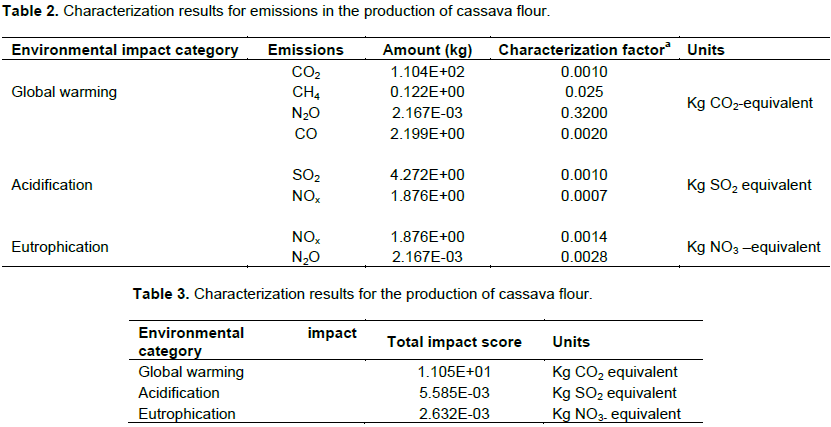
Characterization factors are obtained from Kasmaprapruet et al. (2009) and Frischknecht et al. (2004). The units are obtained from Kasmaprapruet et al. (2009), Ntiamoah and Afrane (2007).
Global warming
As shown in Figures 3 and 4, the major contribution to global warming is the carbon dioxide (CO2) emission from combustion of fossil fuel (coal) for drying operation and combustion of diesel use in the generator to operate the electrical motor during the production operation. 93% of CO2 is emitted from the burning of coal which is used majorly for drying operation while 7% of the total CO2 emission is from the diesel generator. N2O and CH4 emissions from the combustion of diesel fuel and CO emission from coal combustion also contributed to global warming potential. Thus, the drying method involved in cassava flour production in the studied factory using fluidized bed drier and coal as energy source is contributing noticeably to the total global warming in Southwest, Nigeria.
Acidification
The acidification emission of the various processes in cassava flour production is presented in Figure 5. The total acidification in this study is 5.585E-03 kg SO2 equivalent. The drying process has the largest contribution to acidification emission (67.71%) followed by the grinding process (15%), sieving (7%) and packing (6.7%) of the total acidification emissions. The acidification potential was caused mainly from the drying operation due to the atmospheric pollution arising from emission of nitrogen oxides (NOx) and sulphur oxide (SO2) from the combustion of coal which was used to generate heat for the fluidized bed dryer. NOx reacts with hydrogen to produce nitric acid (HNO3) which has an acidifying effect on soils and freshwater (Chartterjee, 2005).
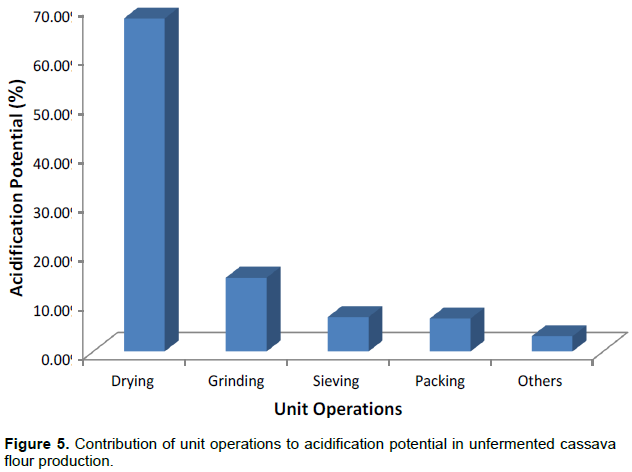
Furthermore in order to enhance whitening during cassava flour production, fumes of heated sulphur is channeled into water which is used for washing and grinding of Cassava tuber, and this form H2SO3 (sulphurous acid). The waste water generated during washing and pressing is channeled into an earth reservoir which is unlined. Thus, the waste water leaches into the soil. H2SO3 lowers the soil pH making the soil unsuitable for planting due to the presence of H+ ions which damage root cell membranes. Also, sulphur can be found in the air in many different forms. It can cause irritations of the eyes and the throat when the uptake takes place through inhalation of sulphur in the gaseous phase (Chartterjee, 2005).
Eutrophication
Eutrophication is a form of water pollution caused by NOx emission from stationary machines used during the flour production process and from NO2 emitted by the combustion of diesel used to generate electricity. Also waste water generated during washing and pressing operation of cassava tuber was discharged into an earth reservoir which is unlined. The waste water leached into the soil and result to eutrophication of the surrounding water bodies.
It has been shown from the case study that the production of unfermented Cassava flour in Southwest Nigeria is contributing to environmental degradation, due to emission of greenhouse gases into the environment from resources used. Particularly, the process has resulted in contributing to global warming potential, acidification and eutrophication impact in the region. Although, drying is an important process operation in the production of unfermented cassava flour, yet the combustion of coal during drying has contributed noticeably to the global warming potential. Furthermore, combustion of diesel fuel in power generation has also been found to impact the environment negatively through emission of harmful gases. The use of flash drying technology and alternative fuel such as biogas/biodiesel could reduce environmental impact associated with Cassava flour production in the region.
The authors have not declared any conflict of interests.
REFERENCES
|
Chartterjee AK (2005). Water Supply, Waste Disposal and Environmental Engineering (Including odour, Noise, Air Pollution and its control). Khanna Publishers 2-B, Nath Marmet, Nai Sarak, Delhi-11006.
|
|
|
|
Cilliers F (2006). Biogas Design and Operation Manual Institude for Agricultureal Engineering, 141 Cress well Road, Silverton Pretoria.
|
|
|
|
|
FAO (2007) Corporate Document Repository: Strategic Environmental assessment.
|
|
|
|
|
Frischknecht R, Jungbluth N, Althaus HJ, Doka G, Dones R, Heck T, Hellwey S, Heischier R, Nemmecek T, Rebizer G, Speielmann M (2004). The Eco-Invent Database: Overview and Methodological Framework. Ecomed Publisher, Landsberg, Germany, and FL Worth/Tx Tokyo, Mumbai, Seoul, Melbourne and Paris.
|
|
|
|
|
Gordon LR (2006). Food Packaging: principles and Practice. Taylor & Francis Group, New York.
|
|
|
|
|
International Fund for Agricultural Development/FAO (2004). A Cassava Industrial Revolution in Nigeria: The potential for a new Industrial crop. The Global Cassava Development Strategy Handbook.
|
|
|
|
|
International Fund for Agricultural Development/FAO (2004). Online Statistical Database. Rome, Italy: Food and Agriculture Organization of the United Nations.
|
|
|
|
|
International Standards Organization (ISO) (1998). Life Cycle Assessment-Impact Assessment ISO 14042
|
|
|
|
|
IPCC (2006). Energy Stationary and mobile combustion. Guidelines for National Greenhouse Gas Inventories.
|
|
|
|
|
ISO (International Organization for Standardization) (1997). Environmental Management-Life Cycle assessment-principles and framework, International standard ISO 14040, ISO, Geneva.
|
|
|
|
|
Kasmaprapruet S, Paengjuntuek W, Saikhwan P, Phungrassami H (2009). Life Cycle Assessment of Milled Rice Production: Case Study in Thailand. Eur. J. Sci. Res. 30(2):195-203.
|
|
|
|
|
Kuiper L, Ekmekci B, Hamelinck C, Hettinga W, Meyer S, Koop K (2007). Bioethanol from cassava. Ecofys Netherlands BV Urecht, The Netherlands.
|
|
|
|
|
NPI (2002). Emission Estimation Technique Manual for combustion Engines Version 2.2
View
|
|
|
|
|
Ntiamoah A, Afrane G (2007). Environmental impacts of cocoa production and processing in Ghana: Life Cycle Assessment approach. J. Cleaner Prod. 16(2008):1735-1740.
|
|
|
|
|
Papong S, Malakul P (2010). Life cycle energy and environmental analysis of bioethanol production from cassava in Thailand. Bioresour. Technol. 101(2010):S112-S118.
Crossref
|
|
|
|
|
SETAC (1993). Guidelines for Life Cycle Assessment. A code of practice, SETAC Workshop Sesimbra, In: Gonzalez, B., Adenso-
|
|
|
|
|
Sidi O (2005). Milling and Baking. Monthly Magazine P 5.
|
|
|
|
|
Strehler A (1998). Necessity and chances of Energy form Biomass and hindrance to success. The 10th European Conference on Biomass for Energy and Industry. June, 1998, Wurzburg Germany.
|
|
|
|
|
UNCTAD (2012). Infocomm Commodity Profile. Cassava.
|
|
|
|
|
United Nations Environment Programme (UNEP) (2002). Evaluation of environmental impacts in life cycle assessment. Meeting report.
|
|
|
|
|
Worldlistmania (2016). World's Largest Cassava Production Countries. .
|
|

